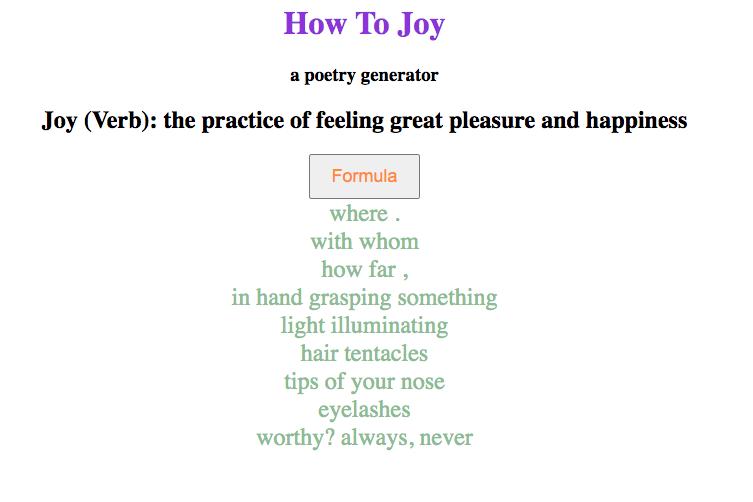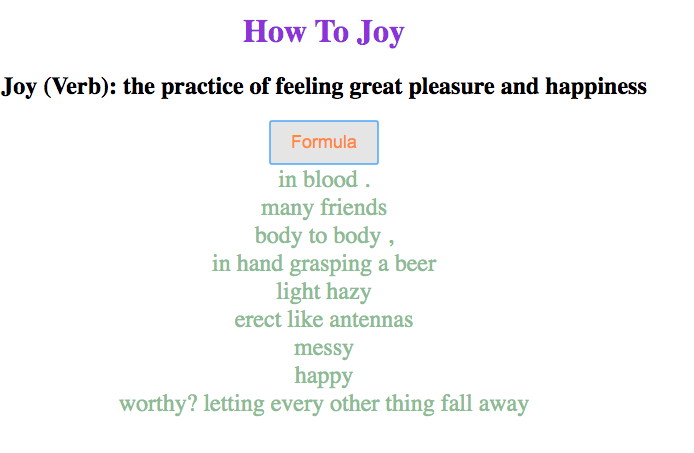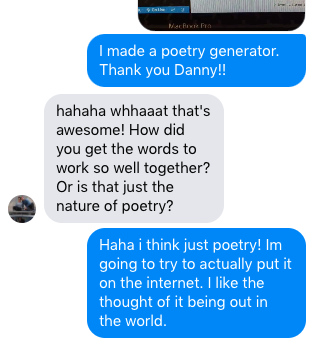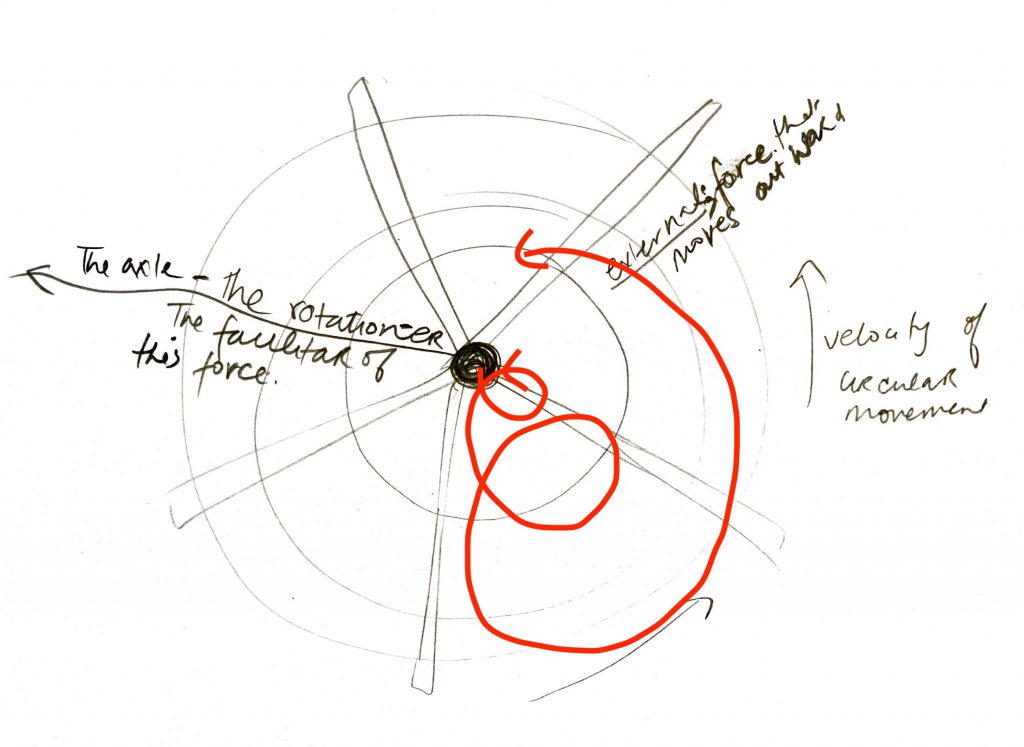Action 11
“There is no formula for joy”, Louise had said to me after last week’s joy workshop. That’s right. There isn’t. In fact joy is probably most palpable when we try not make sense of it- not reduce it to formula.
But I wanted to- make a formula for joy!
I was considering how to best represent the the information gathered from the joy workshop. There were three layers to consider
- The moment of joy experienced by each individual
- The collective feeling of joy that we all felt during the workshop
- And the spreading of further joy through a medium that I choose to represent the knowledge produced in this workshop
I decided to make a website- The Joy Formula Generator
Its a weird link b/c its free. But click it, it works!
https://hungry-wiles-fb75b3.netlify.app/
Its not perfect. It long to figure out this whole process. I haven’t coded much in my life and I have never made a website from scratch so this was a fun endeavour for this week. It got me to connect with an old friend for some advice and actually experiment with a medium that I, for years, have been quite afraid to try out. I was super proud to have explored a more digital process that I know I enjoy, but have a tendency to shy away from.
Logic of Code
I love the logic of coding. Its so linear and everything is packaged and self-referential. It is the exact opposite of how my brain works most days. This is why I chose to make an algorithm to represent a really beautiful, relational, complex moment. I didn’t know if it would work and what it would lead to. I simply meant to create an algorithm that would randomly generate a sequence of words that were brought up in the joy workshop by my classmates to represent their moments of joy.
It was meant to be in irony. To formalize joy seems ridiculous. But at the end, it felt appropriate. How else could I express the information gathered during the workshop other than through poetry?

The code itself refers back to my inquiry of classification systems and the types of mediation that shapes how information is perceived and yields a particular result.
The code below shows how the answers to each of the questions that I asked during the workshop were organized in clustered packages (arrays). I then created an algorithm to randomize words in each of the packages to yield one random word for each of the question. This then yields a set of words that come together as poetry.

On the black screen (the coding interface), all these words that otherwise hold so much emotion and animacy are bereft of life and meaning. In relation to the instruction that surrounds and encapsulates it, they also become a set of instructions. I especially find intriguing the words “in blood”, again encased in a set of instruction, devoid of meaning in stark contrast to the image of someone experiencing tremendous joy while lying in a pool of blood as they give birth to their first born.
Once on the website though, as poetry, it seems to take on meaning again, a new meaning. “In blood” is removed from its initial intention. The “in blood” in the iteration below seems like a description of a messy bar brawl or hockey injuries+singing the national anthem drunk after a victorious hockey game.




Im also thinking about all the code and logic that is hidden and never revealed- sort of a lost in translation moment. I have labeled the package of words associated with the question, “what did your hair feel like?”, as ‘hair’. However, hair is not alluded to in the poems that are generated. I know that pooffy and balmy are referring to a state of hair but for anyone who hasnt experienced pooffy and balmy hair, these words are up for interpretation. I have intentionally opened space for ambiguity. Poetry itself as a form of expression and representation of narrative allows for this sort of ambiguity and open interpretation.
Representing Lived Experiences
This entire semester I have been concerned about how stories about lived experiences are gathered, stored, validated and represented. Storytelling is never a one step process. We can come close to the source to understand a lived experience in its most authentic interpretation when we get lucky enough to be in proximity to the storyteller as someone telling their own story- we get to sit with our grandmothers, hold their wrinkled hands and hear their own voice retell their experiences. I’m lucky; I’ve spent a lot of time with my grandmother. But how do I translate her knowledge to my younger cousin who has been less privileged in this. How do I share this in a way that is true to her experiences, her values and through a means that actively fosters or perpetuates the sentiment implicit in her narrative? This is what I sought to do with all the voices that shared their stories of joy last week. Poetry, I felt was the most appropriate means to share and facilitate that very joy that was felt in that moment. A random set of words connected to a random set of emotions that happen to come together in a way that begets a potent feeling of pleasure and happiness.
Moreover, I mediated these stories as a facilitator and as the algorithm creator. I defined the parameters of what/how these experiences are surfaced and how/what is shared. What is then the role of the mediator and the facilitator in workshopping and bringing people to share?
Centrifugal Means of Self Care
I attended Cissie Fu’s lunch crunch today where were talking about centrifugal type of self care. Care that starts from the centre and is directed inward, the generated force of it can then emit outward. I have been thinking for a while about the facilitator’s role in engaging people in conversation. I imagine the facilitator as the centre of the wheel- I think about the corporeality of the facilitator to their lived experiences that informs their capacity to interpret and push information and knowledge, the weight that they bare, the pressure of moving a whole system to move and to then emit, move outward, the force created from the power of their central movement (see diagram below). That is tiresome, but facilitators and mediators do that work- the labor. Is this what happens when designers become facilitators?

But what happens when the centre of the circle, the facilitator is propelled by self care and self-healing? How does that shift this otherwise exhausting dynamic?

Labour of Care Through Embroidery
To explore this idea of care as a form of labour (here, labour is not pejorative) and of spending time or sharing time with (as mentioned in Reyhan’s vegetable talks), I have decided to spend the winter embroidering a blanket for our class. Embroidery is very therapeutic to me. It is also another form of mediation, a mediation of slow, laborious attentiveness or abstraction and celebration of embodied knowledge in contrast to the logical mediation that was practiced through the designing of code.
I am embroidering images that were drawn by my classmates as they mapped their moment of joy on paper. Those pictographs have associated meaning. They have the power to beget more meaning as tactile clumpy things that emerge out of a knitted blanket to speak a story, to feel familiar yet new, to spawn care and more joy.


